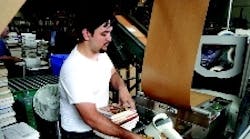Transportation packaging is typically thought of as an end-of-the-line process. For folks like Mark Nason, vice president, operations, and Brian Duarte, director of operations, for rare-book distributor Alibris (Sparks, Nev.), improving the transport packaging process is an essential part of the business plan.
We're a cost center for the company," says Nason, "and anything we can do that minimizes and drops cost, goes directly to the margin line."
And what do productivity and throughput have to do with transportation packaging? Plenty, when you're shipping thousands of books every day.
Nason says he was looking for an automated packaging system that could easily be integrated into existing processes. It had to be reliable, easy to use and, of course, be reasonably priced.
Alibris handles 50 million titles from its 100,000-sq.-ft. distribution center, and its network of more than 10,000 independent rare-book dealers worldwide. It sells books on its website and through partners like Amazon.com, Barnes & Noble and Borders. It prides itself on its "three touch" approach to distribution. The touches refer to the number of times a book is handled from the moment it enters the distribution center until it is sent to a customer.
When books arrive at the facility from a bookseller, an employee opens the package. The book is then given to another employee or, receiver, who checks the book's condition, keys in an order number that generates a packing slip, puts the packing slip inside the book, then places it into the appropriate tote. Appropriate, in this case, depends on the book's sales channel or carrier assignment.
Once a tote is full, it is placed on a belt conveyor. Totes carry a bar code label, used for automated sorting and tracking to the correct packaging lane.
For shipping, the company had been using cardboard "t-fold" packages. Although the "t-folds" were more expensive than flat cardboard, the process increased shipments per employee each day by 50%. The "t-fold" packages, however, also had drawbacks. The company experienced scuffing and some "fall outs"—the book would literally fall out of the package—during shipping. Finally, because of openings inherent in a "t-fold" configuration, the package was not water-resistant and moisture would sometimes get into the package.
Solving the problem
Alibris found its solution—a somewhat novel packaging method—with Sealed Air Corp.'s (Saddle Brook, N.J.) PriorityPak automated packaging system.
"We were excited to learn there is an automated packaging system available that met our criteria," says Nason. "This new machine dovetailed with our operation and leveraged what we already had as a streamlined process."
At the heart of the system is smartsensing technology that scans an item's dimensions. This information is then used to deliver the correct amount of cohesive-coated rigid board from two supply rolls to the system.
Engineers at Alibris worked with Mike Ovesen, an automated systems specialist for Sealed Air, to design the project. Together, they determined what materials would be required to package a common-size book, including the type and width of material, and how many material roll changes would be needed during a typical day.
Next, samples of the final package created by the PriorityPak system were supplied so that shipping tests could be conducted and various departments within Alibris, including marketing, could evaluate performance and aesthetics.
Test for success
Testing of the new system lasted three days. "The team from Sealed Air trained me and three others on how to use the system," says Duarte. "However, there wasn't really much training needed because the system is very intuitive and easy to use."
Today, when a tote is conveyed to the packaging lane, the operator removes a book; removes the packing slip and scans it. This alerts the system to the proper address and postage to print on the label. The operator places the book on the bottom material web of the PriorityWrap rigid board and hits a button to begin the packaging process.
As the book moves through the system, the smartsensing technology scans the book's dimensions to deliver the correct amount of cold seal, cohesive-coated rigid board from two supply rolls. The specially formulated coating sticks to itself to create a seal around all four sides of the book. As the two sheets of rigid board are fed into the system, a patented roller system creates a crescent seal that suspends the product. By suspending the books in this manner, product shifting is minimized.
The operator applies the address and postage label to the top web of material. The package then drops onto a belt conveyor and moves to a bin for shipping. The whole packaging process takes seconds.
"The system is twice as fast as any of the other packaging systems we evaluated," says Nason.
Textbook results
"Our ROI on the system was almost immediate," says Nason. "We had accurately estimated the savings on the labor factor, however we were pleasantly surprised with the savings on weight of the lighter material we now use."
Almost immediately after the installation, Alibris doubled productivity compared to the cardboard " tfold" packages. The company now averages 2,500 to 3,500 packages per day processed through a single PriorityPak system. Because the package is nearly five ounces lighter than the cardboard "t-folds," the company saves on shipping costs because of the reduced weight.
Initially, Nason projected a six month return-oninvestment with the new system. Three months after installation, it had achieved 70% of its projected ROI. Nason believes Alibris' savings in postage, material and labor will add up to more than $325,000 annually.
A packaging operator places a book on the bottom material web of the PriorityWrap rigid board as the first step in the packaging process.
The operator scans the packing slip to create the address and postage label, then applies the label to the top web of rigid board material. The book's dimensions will be scanned and the correct amount of packaging material dispensed onto the rolls.






